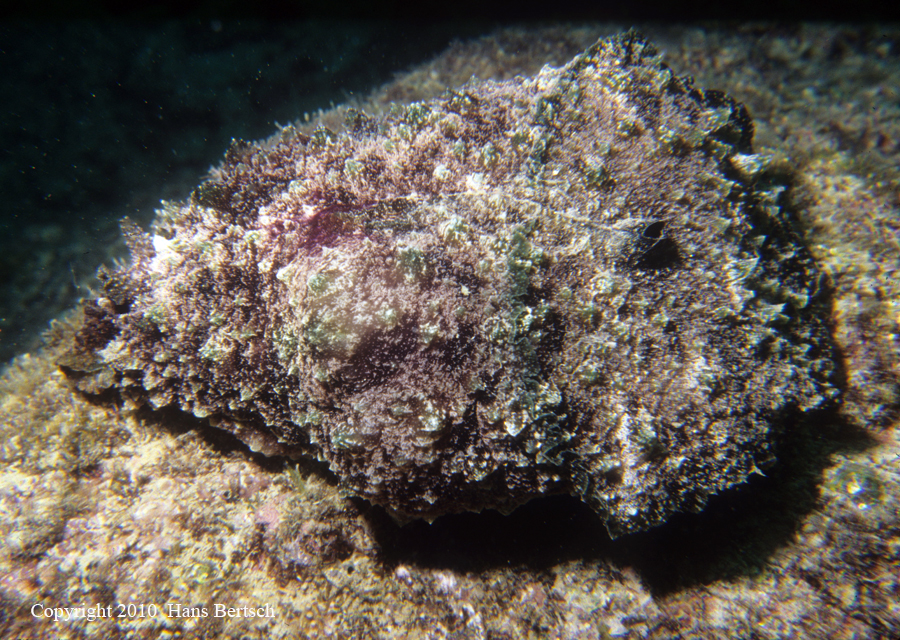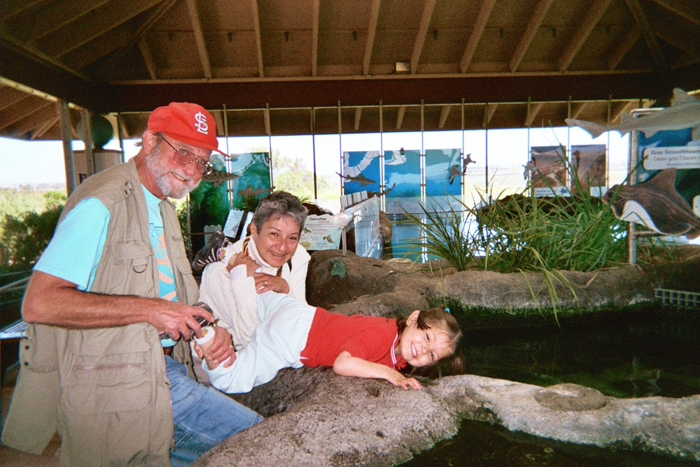 |
Dolabella auricularia
Bahía de los Muertos, BCS, México
Photo by Hans Bertsch
Dolabella auricularia (Lightfoot, 1786)
Enough with pretty, little slugs from exotic Indo-Pacific dive sites. This week's BOW is a big, ugly Anaspidea that I have seen in my “backyard,” the southern Gulf of California (=Sea of Cortez). Note however, that it can be readily found by all I-P tropical divers. It ranges across that entire oceanic basin, from South Africa and the Red Sea to Hawai'i, and from New South Wales, Australia, to South Korea. In the eastern Pacific, it is known from Mulege, in the central Sea of Cortez, to Ecuador and the Galápagos and Easter Islands.
A species with many synonyms, tropical west American species have been named Dolabella californica Stearns, 1878 (based on a single specimen collected alive at Mulege by William J. Fisher), D. guayaquilensis Sowerby, 1868 (in his Conchologia Iconica; or, Illustrations of the Shells of Molluscous Animals, based on a single shell from Ecuador), and D. agassizi MacFarland, 1918 (based on a single shore-collected specimen at Easter Island). MacFarland correctly used the single -i termination for the genitive; incorrect use of –ii for older species such as Hypselodoris agassizii (Bergh, 1894) has been allowed, but not for new species!
This giant (reaching 50 cm) sea hare is immediately recognized by its blunt end. Its vertically flat posterior looks as if the animal had crossed a chopping block too slowly. It resembles the once-popular, but long-failed, US automobile, the Gremlin, which had a diced-off hatchback design.
The well-developed calcareous internal shell is scoop- (or hatchet-) shaped, with a horny brown or gray periostracum on one side. It is the only species of aplysiid named on the basis of its shell shape. The species name auricularia is based on the Latin auricula, diminutive for auris, ear.
MacFarland (1918: 316) described “the large and strong amber radula. In situ its exposed surface presents a conventional heart-shape....The highest portions of the radula thus form the sides of [a] median groove, and round over toward the sides and more abruptly in front. The rows of functional teeth curve around over this elevated surface....Deep in the median groove [=posterior] the youngest teeth are covered with the epithelium of the sheath.” A radula presents an interesting picture of growth, with ontogenetic stages of tooth formation clearly visible (see Bertsch, 1976).
The narrow, unicuspid (claw-like) lateral radular teeth are numerous, “the total number of teeth probably being not far from 25,000" (MacFarland, 1918). Its radular formula varies at least from 54-62 x 198-230.1.198-230.
MacFarland's skills as an exactingly precise anatomist are fully displayed in the detailed descriptions and illustrations he made from the single Easter Island specimen he dissected.
The green (or dirty yellow-brown) egg mass is the typical aplysiid spaghetti-shaped coiled string. Perhaps it is appropriate that it is a “marine delicacy sold in many Filipino restaurants” (Richard Parker, 2006, Message 17296, Sea Slug Forum). “Many families in the coastal regions in Visayas and Mindanao Islands of Philippines use these eggs for food, and this is slowly growing [in] popularity in different areas of the country” (Lorraine M. Cueva, 2009, Message 22667, Sea Slug Forum ). This seems almost contradictory to our gustatory liking, since few opisthobranch species are eaten (willingly) by humans!
Last year, Dr. Carlos Cáceres Martínez and I led an invertebrate zoology field trip to Isla Espiritu Santo (north of La Paz, Baja California Sur). While rock-rolling during a low tide, we found a D. auricularia between a rock and a sandy place. It was a smallish 13 cm, hand size , but still inked, as shown by student Juan Arce Hernandez's photo . Underwater the inking behavior may have a better adaptive value. From a human's standpoint, the hearty cloud of purple seems to block any successful visual search and capture.
A simple Google search (0.18 seconds) yielded 68,900 online references for Dolabella auricularia. Information on its natural history, population dynamics and herbivory can be found in papers such as Behmer et al. (2002), Lozado et al. (2005), Pauly & Calumpong (1984) and Pennings et al. (1993).
There have been many chemical studies of D. auricularia, including the molecular structure of its hemocyanin, carotenoids, myoglobin, phosphonoglycolipids, etc. Especially important are investigations into the pharmacological properties and uses of this species' chemicals, e.g., antimitotic depsipeptides, and antimicrobial and antineoplastic peptides.
Conservation issues (to protect marine habitats and species from threats by global warming acidification, pollution, unsustainable uses and other anthropogenic factors) must be addressed and resolved, not just for the health of the slugs, but for our own health, and for the health of all members of our global ecosystem.
Beauty may be only in the mind of the beholder. Dolabella auricularia may not have hallucigenia, magnificum, or psychedelicum photogenic appeal, but (paraphrasing Steinbeck and Ricketts, 1941) IT IS. And maybe from such a thing as that, Beethoven could have written a Ninth Symphony to Schiller's Ode to Joy (p. 38). It is—now that's beautiful!
References
Behmer, Spencer T., Stephen J. Simpson and David Raubenheimer
2002. Herbivore foraging in chemically heterogeneous environments: Nutrients and secondary metabolites. Ecology 83 (7): 1935-1944.
Bertsch, Hans
1976. Intraspecific and ontogenetic radular variation in opisthobranch systematics (Mollusca: Gastropoda). Systematic Zoology 25 (2): 117-122.
Lightfoot, John
1786. In: A Catalogue of the Portland Museum, lately the property of the Duchess Dowager of Portland, deceased: which will be sold by auction, etc. London. [See: Keen, 1971, Sea Shells of Tropical West America, 2nd edition]
Lozado, Wendy M., L. A. J. Flores, R. M. Tan and Danila T. Dy
2005. Abundance and ingestion rate of the sea hare, Dolabella auricularia (Lightfoot, 1786) in shallow embayment (Eastern Mactan Is., Cebu, Central Philippines. Philipp. Scient. 42: 67-78.
MacFarland, Frank Mace
1918. Reports on the scientific results of the expedition to the tropical Pacific, in charge of Alexander Agassiz, by the U.S. Fish Commission Steamer “Albatross,” from August, 1899, to June, 1900, Commander Jefferson F. Moser, U.S.N., commanding. XIX. The Dolabellinae. Memoirs of the Museum of Comparative Zoology, Harvard College 35 (5): 297-348; plts. 1-10.
Pauly, D. and H. Calumpong
1984. Growth and mortality of the sea hare Dolabella auricularia (Gastropoda: Aplysiidae) in the central Visayas, Philippines. Marine Biology 79: 289-293.
Pennings, Steven C., Masatomo T. Nadeau and Valerie J. Paul
1993. Selectivity and growth of the generalist herbivore Dolabella auricularia feeding upon complementary resources. Ecology 74 (3): 879-890.
Stearns, R. E. C.
1878. Description of a new species of Dolabella from the Gulf of California, with remarks on other rare or little-known species from the same region. Proc. Acad. Nat. Sci. Phil. 30: 395-401.
Steinbeck, John, and Edward F. Ricketts
1941. Sea of Cortez. Paul P. Appel Publishers, Mamaroneck, NY. 589 pp.
Imperial Beach, Calif
Feb., 2010

|
